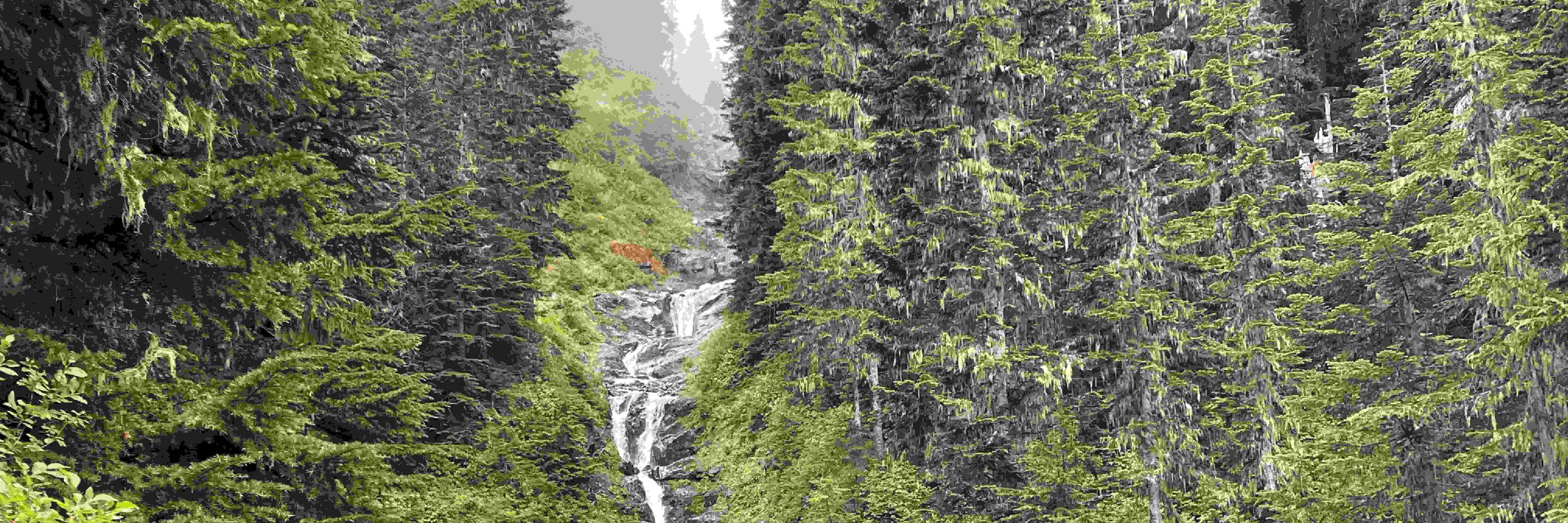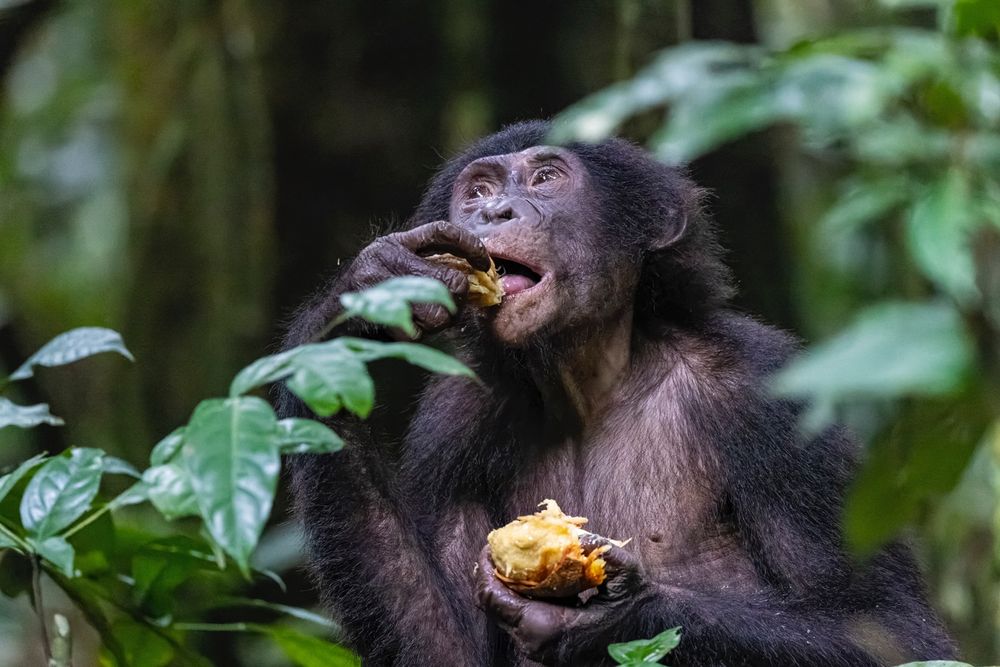
Evan Fricke
@efricke.bsky.social
Biodiversity, ecology, climate change, forests, seed dispersers.
Research scientist at MIT.
Research scientist at MIT.
Thanks for spreading the word! Check out a thread about our work here👇
Our new study shows how animal biodiversity loss is a climate problem: tropical forests recover far less carbon where seed dispersers have declined.
We’re not just losing forests – we’re losing their ability to regrow.
Reversing that trend could align biodiversity recovery with climate solutions.🧵
We’re not just losing forests – we’re losing their ability to regrow.
Reversing that trend could align biodiversity recovery with climate solutions.🧵

Seed dispersal disruption limits tropical forest regrowth | PNAS
Identifying linkages between biodiversity loss and climate change is required for
understanding the scope of these interconnected challenges and de...
www.pnas.org
July 28, 2025 at 4:44 PM
Thanks for spreading the word! Check out a thread about our work here👇
Thank you for reading and sharing!
Deep thanks to the stellar coauthors Susan Cook-Patton, Charlie Harvey, and César Terrer. And to photographer Christian Ziegler for these excellent seed disperser images.
Deep thanks to the stellar coauthors Susan Cook-Patton, Charlie Harvey, and César Terrer. And to photographer Christian Ziegler for these excellent seed disperser images.
July 28, 2025 at 4:41 PM
Thank you for reading and sharing!
Deep thanks to the stellar coauthors Susan Cook-Patton, Charlie Harvey, and César Terrer. And to photographer Christian Ziegler for these excellent seed disperser images.
Deep thanks to the stellar coauthors Susan Cook-Patton, Charlie Harvey, and César Terrer. And to photographer Christian Ziegler for these excellent seed disperser images.
The take-home message is clear.
Overlooking nature’s tree planters risks missing ‘win-win’ pathways for both climate mitigation and biodiversity conservation.
Overlooking nature’s tree planters risks missing ‘win-win’ pathways for both climate mitigation and biodiversity conservation.

July 28, 2025 at 4:41 PM
The take-home message is clear.
Overlooking nature’s tree planters risks missing ‘win-win’ pathways for both climate mitigation and biodiversity conservation.
Overlooking nature’s tree planters risks missing ‘win-win’ pathways for both climate mitigation and biodiversity conservation.
These numbers help show where natural regrowth can be effective, in which areas a human hand is needed to meet climate mitigation potential, or how we can leverage seed dispersers’ roles to amplify forest restoration.

July 28, 2025 at 4:41 PM
These numbers help show where natural regrowth can be effective, in which areas a human hand is needed to meet climate mitigation potential, or how we can leverage seed dispersers’ roles to amplify forest restoration.
Despite seed disperser decline, natural regrowth still matches or exceeds the carbon gains of tree planting by people in many areas.
And natural regrowth often has much lower implementation costs and better biodiversity outcomes.
And natural regrowth often has much lower implementation costs and better biodiversity outcomes.

July 28, 2025 at 4:41 PM
Despite seed disperser decline, natural regrowth still matches or exceeds the carbon gains of tree planting by people in many areas.
And natural regrowth often has much lower implementation costs and better biodiversity outcomes.
And natural regrowth often has much lower implementation costs and better biodiversity outcomes.
Two key findings:
-Aboveground carbon accumulates 4x faster in regrowing tropical forests where seed dispersal by animals is most intact vs. most disrupted.
-Current seed dispersal disruption levels cut carbon uptake of proposed reforestation sites by 57% on average.
-Aboveground carbon accumulates 4x faster in regrowing tropical forests where seed dispersal by animals is most intact vs. most disrupted.
-Current seed dispersal disruption levels cut carbon uptake of proposed reforestation sites by 57% on average.

July 28, 2025 at 4:41 PM
Two key findings:
-Aboveground carbon accumulates 4x faster in regrowing tropical forests where seed dispersal by animals is most intact vs. most disrupted.
-Current seed dispersal disruption levels cut carbon uptake of proposed reforestation sites by 57% on average.
-Aboveground carbon accumulates 4x faster in regrowing tropical forests where seed dispersal by animals is most intact vs. most disrupted.
-Current seed dispersal disruption levels cut carbon uptake of proposed reforestation sites by 57% on average.
We combined results of thousands of local field studies on seed-dispersing animals and human impacts to map a ‘seed dispersal disruption’ index across the tropics.
We then paired it with carbon accumulation data from thousands of tropical regrowth plots, along with other environmental variables.
We then paired it with carbon accumulation data from thousands of tropical regrowth plots, along with other environmental variables.

July 28, 2025 at 4:41 PM
We combined results of thousands of local field studies on seed-dispersing animals and human impacts to map a ‘seed dispersal disruption’ index across the tropics.
We then paired it with carbon accumulation data from thousands of tropical regrowth plots, along with other environmental variables.
We then paired it with carbon accumulation data from thousands of tropical regrowth plots, along with other environmental variables.
Motivation: Tropical regrowth forests are currently the largest contributor to the land carbon sink, which absorbs a third of global emissions annually.
But over 80% of tropical trees rely on animals to regenerate, and seed dispersers are declining. What does that mean for tropical forest regrowth?
But over 80% of tropical trees rely on animals to regenerate, and seed dispersers are declining. What does that mean for tropical forest regrowth?

Drivers and impacts of global seed disperser decline
Nature Reviews Biodiversity - Many plants rely on animals to disperse their seeds, but some groups of these seed-dispersing animals are facing severe declines. This Review summarizes evidence of...
rdcu.be
July 28, 2025 at 4:41 PM
Motivation: Tropical regrowth forests are currently the largest contributor to the land carbon sink, which absorbs a third of global emissions annually.
But over 80% of tropical trees rely on animals to regenerate, and seed dispersers are declining. What does that mean for tropical forest regrowth?
But over 80% of tropical trees rely on animals to regenerate, and seed dispersers are declining. What does that mean for tropical forest regrowth?
We’d love your help spreading this (the message, not the seeds - though both matter!)
Big thanks to the stellar coauthors: Carolina Bello, Becky Chaplin-Kramer (@beckyck.bsky.social), Daisy Dent, Ken Feeley (@kjfeeley.bsky.social), Mauro Galetti, Juanpe González-Varo, Ruben Heleno, Leighton Reid.
Big thanks to the stellar coauthors: Carolina Bello, Becky Chaplin-Kramer (@beckyck.bsky.social), Daisy Dent, Ken Feeley (@kjfeeley.bsky.social), Mauro Galetti, Juanpe González-Varo, Ruben Heleno, Leighton Reid.

May 19, 2025 at 1:35 AM
We’d love your help spreading this (the message, not the seeds - though both matter!)
Big thanks to the stellar coauthors: Carolina Bello, Becky Chaplin-Kramer (@beckyck.bsky.social), Daisy Dent, Ken Feeley (@kjfeeley.bsky.social), Mauro Galetti, Juanpe González-Varo, Ruben Heleno, Leighton Reid.
Big thanks to the stellar coauthors: Carolina Bello, Becky Chaplin-Kramer (@beckyck.bsky.social), Daisy Dent, Ken Feeley (@kjfeeley.bsky.social), Mauro Galetti, Juanpe González-Varo, Ruben Heleno, Leighton Reid.
There’s still much to learn:
• Which plants and ecosystems are most vulnerable to disperser loss?
• How do disperser declines interact with other change drivers?
• What are (and how can we measure) the costs to human well-being?
• What strategies best restore seed dispersal and its benefits?
• Which plants and ecosystems are most vulnerable to disperser loss?
• How do disperser declines interact with other change drivers?
• What are (and how can we measure) the costs to human well-being?
• What strategies best restore seed dispersal and its benefits?
May 19, 2025 at 1:35 AM
There’s still much to learn:
• Which plants and ecosystems are most vulnerable to disperser loss?
• How do disperser declines interact with other change drivers?
• What are (and how can we measure) the costs to human well-being?
• What strategies best restore seed dispersal and its benefits?
• Which plants and ecosystems are most vulnerable to disperser loss?
• How do disperser declines interact with other change drivers?
• What are (and how can we measure) the costs to human well-being?
• What strategies best restore seed dispersal and its benefits?
But we’re making progress.
New data syntheses and models are capturing functional changes across large scales, helping reveal long-term impacts, which range from reduced forest product provisioning and weakened carbon storage to impaired wildfire recovery and degraded habitats for animals.
New data syntheses and models are capturing functional changes across large scales, helping reveal long-term impacts, which range from reduced forest product provisioning and weakened carbon storage to impaired wildfire recovery and degraded habitats for animals.

May 19, 2025 at 1:35 AM
But we’re making progress.
New data syntheses and models are capturing functional changes across large scales, helping reveal long-term impacts, which range from reduced forest product provisioning and weakened carbon storage to impaired wildfire recovery and degraded habitats for animals.
New data syntheses and models are capturing functional changes across large scales, helping reveal long-term impacts, which range from reduced forest product provisioning and weakened carbon storage to impaired wildfire recovery and degraded habitats for animals.
Why are seed dispersers missing from the conversation?
One idea: Experiments can demonstrate societally relevant impacts of pollinator decline within a growing season. For seed disperser decline, they unfold slowly, across vast scales, and experiments at scale are unfeasible or unethical.
One idea: Experiments can demonstrate societally relevant impacts of pollinator decline within a growing season. For seed disperser decline, they unfold slowly, across vast scales, and experiments at scale are unfeasible or unethical.

May 19, 2025 at 1:35 AM
Why are seed dispersers missing from the conversation?
One idea: Experiments can demonstrate societally relevant impacts of pollinator decline within a growing season. For seed disperser decline, they unfold slowly, across vast scales, and experiments at scale are unfeasible or unethical.
One idea: Experiments can demonstrate societally relevant impacts of pollinator decline within a growing season. For seed disperser decline, they unfold slowly, across vast scales, and experiments at scale are unfeasible or unethical.
Seed disperser decline threatens plant biodiversity, connectivity, and resilience.
Yet despite these being core goals of global efforts to protect, manage, and restore nature, the roles of seed dispersers remain largely overlooked in global biodiversity and restoration strategies.
Yet despite these being core goals of global efforts to protect, manage, and restore nature, the roles of seed dispersers remain largely overlooked in global biodiversity and restoration strategies.

May 19, 2025 at 1:35 AM
Seed disperser decline threatens plant biodiversity, connectivity, and resilience.
Yet despite these being core goals of global efforts to protect, manage, and restore nature, the roles of seed dispersers remain largely overlooked in global biodiversity and restoration strategies.
Yet despite these being core goals of global efforts to protect, manage, and restore nature, the roles of seed dispersers remain largely overlooked in global biodiversity and restoration strategies.
The majority of plant species rely on animals to move their seeds. Birds, mammals, and other seed dispersers shape plant biodiversity, recovery from disturbance, and responses to climate change.
But this is breaking down as seed disperser diversity, abundance, and movement decline worldwide.
But this is breaking down as seed disperser diversity, abundance, and movement decline worldwide.

May 19, 2025 at 1:35 AM
The majority of plant species rely on animals to move their seeds. Birds, mammals, and other seed dispersers shape plant biodiversity, recovery from disturbance, and responses to climate change.
But this is breaking down as seed disperser diversity, abundance, and movement decline worldwide.
But this is breaking down as seed disperser diversity, abundance, and movement decline worldwide.

